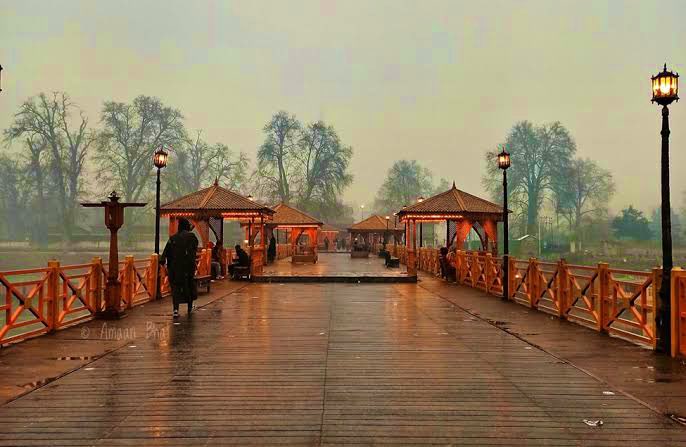Rajbagh Riverfront Culture Drift – Social Media, Teen Distraction, and the Erosion of Values
By: Javid Amin | 22 Aug 2025
Rajbagh Riverfront – From Serenity to Spectacle
On a clear afternoon in Srinagar, the Rajbagh riverfront paints a picture both familiar and startling. The calm Jhelum River flows steadily, its banks lined with graceful chinars, whispers of heritage echoing in the breeze. Elderly men sit on benches, absorbed in conversation; a few families stroll quietly; vendors sell snacks and tea. And yet, dominating the scene are groups of teenagers—particularly young girls—who gather in circles, holding up smartphones, laughing, lip-syncing to Bollywood songs, and recording reels for Instagram.
What once was a place of reflection, quiet storytelling, and cultural togetherness has transformed into a stage for digital performance. The Rajbagh riverfront, like many public spaces across India, is no longer only about heritage—it has become a backdrop for visibility, attention, and curated identity.
The Scene That Sparked Unease
At first glance, there’s nothing alarming about teenagers enjoying themselves. Singing songs, dancing, and expressing joy in public spaces has always been a part of youth culture worldwide. But what raises concern in Kashmir—and particularly at Rajbagh—is the pattern and priorities.
-
Students bunking school hours to spend time at the riverfront.
-
Endless attempts to create the “perfect reel”—sometimes at the cost of safety, as they lean over barriers or film on the road.
-
Content mimicking Bollywood or internet trends, often disconnected from Kashmiri identity, history, or social context.
In itself, this is not “wrong.” But it reflects a deeper shift: education and purpose being sidelined for digital distraction.
Why the Concern?
-
Education vs. Entertainment – Skipping classes for reels reflects not just a personal choice but a growing misalignment of priorities.
-
Cultural Disconnect – Kashmir’s rich heritage of poetry, music, storytelling, and spirituality is being replaced by imitative content.
-
Performative Identity – Teenagers today increasingly define themselves by likes, comments, and followers rather than values, skills, or achievements.
The concern is not about joy—it’s about direction. When digital visibility begins to overshadow discipline, learning, and cultural grounding, a generation risks being raised on distraction rather than depth.
Reels Over Roots: The Power and Trap of Social Media
Why are reels so irresistible to teenagers, especially at places like Rajbagh?
The answer lies in social media psychology. Platforms like Instagram, TikTok (before its ban in India), and YouTube Shorts are engineered to reward instant gratification.
-
A like = dopamine rush.
-
A share = social validation.
-
A comment = belonging.
For a teenager navigating identity and peer approval, these micro-rewards are addictive. Instead of finding validation through skills, achievements, or community, validation is outsourced to the screen.
The Illusion of Fame
Creating a reel may take only 30 seconds, but the cycle of filming, editing, retakes, and reposting can consume hours of a student’s day. The goal is rarely artistic—it’s algorithmic: “Will this trend get me more likes?”
The result is a culture of mimicry, not creativity. Reels are about copying songs, dances, or dialogues—not original expression. This erodes individuality and replaces it with performative sameness.
What Studies Say
-
A 2022 Pew Research study found that 57% of teens felt “addicted” to social media.
-
Research published in Journal of Adolescence shows that excessive social media use correlates with higher anxiety and lower academic performance.
-
In India, surveys reveal that over 65% of students spend 3–6 hours daily on social media, often during school hours.
At Rajbagh, this global pattern is visible in local colors—young Kashmiri girls choosing reels over roots, likes over learning.
Parenting in the Age of Digital Distraction
The question then arises: Where are the parents?
The uncomfortable answer is that many parents are either unaware or silently complicit.
1. Unaware Parents
Many families in Kashmir—like elsewhere—struggle with economic challenges, work pressures, and post-conflict anxieties. Parents are often too busy to track their children’s whereabouts after school. Some don’t even know their daughters are at Rajbagh instead of class.
2. Silent Parents
Another section knows but remains silent. They see reels as harmless fun or even symbols of modernity. For them, permissiveness is mistaken as progressiveness.
Both responses, however, miss the point. Parenting is not about policing—it’s about presence.
Children need emotional engagement, cultural storytelling, and moral anchoring. When homes fall silent, social media fills the vacuum. But instead of meaning, it provides noise. Instead of roots, it offers reels.
Why Silence is Dangerous
A generation without boundaries is a generation without direction. Freedom without responsibility is not empowerment—it’s confusion.
Rajbagh Riverfront: Reels, Roots, and the Risk of a Distracted Generation
Freedom vs. Flippancy – Where Do We Draw the Line?
Every society wrestles with the balance between freedom and responsibility. Teenagers should absolutely have space to explore, express, and experiment. Yet, freedom is not the same as flippancy.
True freedom emerges when one has:
-
Discipline – the ability to say no to distractions.
-
Awareness – knowing the difference between real progress and superficial trends.
-
Self-respect – valuing one’s culture, roots, and dignity.
At Rajbagh, what we see today is not freedom—it’s a curated illusion. A reel may look glamorous on Instagram, but behind the lens, it often reflects confusion, peer pressure, and emptiness.
The Illusion of Liberation
For many teens, bunking classes and dancing at the riverfront feels like a statement of independence. But if independence is reduced to mimicking Bollywood lyrics or TikTok trends, it’s not liberation—it’s conformity in disguise.
Real empowerment would be:
-
Girls debating ideas, not just dialogues.
-
Youth organizing poetry readings, art sessions, or music evenings at Rajbagh.
-
Teenagers turning reels into stories of Kashmiri heritage, not just 15-second mimicry.
Without this shift, freedom risks becoming frivolity.
Cultural Drift: Losing Roots in the Scroll
Kashmir has always been a land of deep cultural identity. From the verses of Lal Ded and Habba Khatoon to the quiet rhythm of sufiyana music, the valley’s heritage is built on meaning, not mimicry.
But today’s Rajbagh reels show a drift from this cultural core.
-
Instead of Kashmiri folk songs, we hear Bollywood remixes.
-
Instead of local stories, we see copied internet challenges.
-
Instead of honoring heritage, youth are chasing fleeting algorithms.
This isn’t just a generational quirk. It’s a cultural displacement. When teenagers prefer reels over roots, the collective memory of a society weakens.
What We Risk Losing
-
Language – Kashmiri and Urdu poetry sidelined by Hindi-English mashups.
-
Music – traditional instruments replaced by phone speakers blaring film songs.
-
Identity – pride in being Kashmiri diluted by digital conformity.
As one Srinagar teacher recently remarked, “We’re not just losing students from classrooms—we’re losing stories from our culture.”
Global Parallels: This Isn’t Just a Kashmir Issue
What’s happening at Rajbagh riverfront is part of a larger global pattern. Cities worldwide face similar shifts where digital culture reshapes youth behavior.
Seoul, South Korea
Public parks often turn into open studios where K-pop fans record reels and TikToks. The obsession with looking “camera-ready” has led to rising cases of anxiety and body image issues among teenagers.
New York City
On weekends, public spaces like Washington Square Park see crowds of teens live-streaming or recording reels. Teachers complain of declining attention spans, while psychologists note the rise of “validation anxiety.”
Paris
Even iconic spaces like the Eiffel Tower have become backdrops for influencers. Locals often complain that cultural pride is being reduced to “social media props.”
India Beyond Kashmir
In Delhi’s Connaught Place or Mumbai’s Marine Drive, the scene mirrors Rajbagh—students bunking classes, gathering for reels, chasing digital attention.
The problem, then, is not about Kashmir being “different” but about Kashmir being swept into a global tide where identity risks being flattened by algorithms.
What Makes Kashmir’s Case Unique
While the global trend is real, Kashmir carries unique sensitivities:
-
Conflict Zone Legacy – A generation already raised amid uncertainty now seeks distraction more intensely. Social media becomes a coping mechanism, but also an escape from reality.
-
Cultural Depth – Unlike many urban spaces, Kashmir has an extraordinary legacy of art, literature, and spirituality. Losing this heritage is not just a loss of tradition—it’s a loss of identity.
-
Societal Sensitivity – In a place where public morality and cultural pride are deeply tied to religion and heritage, the drift toward mimicry feels like a betrayal of values.
In short, the Rajbagh phenomenon is not just about students skipping classes—it’s about an entire society standing at a cultural crossroads.
Reclaiming Rajbagh: Building a Balance Between Culture and Modernity
Community Dialogues – Talking Before It’s Too Late
One of the most powerful remedies for cultural drift is conversation.
But not the kind that happens on social media comment sections. Real, face-to-face community forums where parents, teachers, elders, and youth sit together.
-
Local Forums: Rajbagh and other neighborhoods could host monthly discussions in community halls, mosques, schools, or even riverside gatherings.
-
Shared Ownership: Instead of blaming teenagers, involve them in shaping the agenda. Ask them: What kind of freedom do you want? What kind of Kashmir do you want to represent online?
-
Digital Ethics Sessions: Invite experts to speak on how social media algorithms work—so youth understand how their “freedom” is often manipulated by platforms chasing profit.
When a society talks, it listens. And when it listens, it heals.
Creative Campaigns – From Reels to Roots
Instead of dismissing reels entirely, why not redirect them? Social media itself can become a tool for cultural revival.
-
#ReclaimRajbagh: A campaign encouraging youth to shoot reels about Kashmiri culture, poetry, crafts, and nature instead of Bollywood mimicry.
-
Storytelling Saturdays: Organize weekly events at Rajbagh where teens can perform folk songs, recite Kashmiri poetry, or showcase original music—and then post it online.
-
Youth as Influencers of Culture: Encourage schools and NGOs to mentor teen influencers who promote heritage-based creativity.
This way, the reel doesn’t die—it transforms.
School Partnerships – Education Beyond the Classroom
If students are bunking classes to hang out at Rajbagh, the question is: What are schools failing to offer inside classrooms?
-
Emotional Literacy Programs: Beyond math and science, students need lessons in self-awareness, discipline, and emotional health.
-
Heritage Integration: Teach Lal Ded, Habba Khatoon, Sheikh-ul-Alam not as “past poets,” but as living guides for identity.
-
Digital Behavior Courses: Schools must openly address Instagram, TikTok, and reels—not as taboos but as realities, teaching students how to use them wisely.
-
Extracurricular Revival: Debate clubs, theatre, music bands, sports leagues—activities that give students purpose beyond reels.
Education should feel relevant, exciting, and rooted—not just a race for marks.
Parent Toolkits – Rebuilding the Family-Society Bridge
Much of the Rajbagh drift stems from parental silence or ignorance. Parents often:
-
Don’t know where their children go after school.
-
Assume “freedom” means no boundaries.
-
Are too busy or disconnected to engage deeply.
Solutions:
-
Weekly Check-ins: A simple 15-minute conversation at dinner where parents ask, not lecture: What did you do today?
-
Digital Literacy for Parents: Workshops teaching parents about reels, trends, and how to guide children without appearing outdated.
-
Cultural Storytelling: Revive the old tradition of parents or grandparents narrating stories, sufi poetry, and family histories at home.
A child who feels heard at home is less likely to seek validation in likes and shares.
Policy and Governance – Regulation With Sensitivity
The state has a role to play—but with balance. Over-policing teenagers will backfire. Instead, policies should focus on:
-
Safe Public Spaces: Rajbagh riverfront can be developed as a cultural zone with open libraries, art spaces, and supervised youth activities.
-
Digital Literacy Drives: Government campaigns on responsible social media use, like road safety campaigns, but youth-friendly in tone.
-
Youth Councils: Involving young voices in policymaking so they feel responsible, not excluded.
-
Partnership with Tech Platforms: Pressure social media companies to promote local culture content instead of flooding feeds with mimicry trends.
A Balanced Future – Joy With Dignity
This isn’t about policing joy or turning Rajbagh into a moral battlefield. Youth should laugh, sing, dance, and make memories. But those memories should carry meaning, dignity, and cultural pride.
Imagine a Rajbagh where:
-
Girls sing Habba Khatoon alongside Bollywood tunes.
-
Teens shoot reels that celebrate Kashmir’s rivers, crafts, and stories.
-
Parents join their children for an evening of poetry or music at the riverfront.
-
Schools and community groups organize monthly “heritage evenings” by the water.
Such a vision doesn’t kill freedom—it elevates it.
Rajbagh Riverfront: Between Distraction and Destiny
A Mirror of Our Times
The Rajbagh riverfront is more than just a scenic spot—it has become a mirror of Kashmir’s cultural crossroad. On one side, there is laughter, music, and reels. On the other, there is worry, silence, and the creeping sense of cultural erosion.
This tension is not unique to Kashmir. Every society grapples with modernity vs. tradition, freedom vs. discipline, individuality vs. identity. But Rajbagh stands out because the shift is happening in real-time, in plain sight, and yet, too many are watching passively.
The truth is: a generation is not “lost” yet—it is only searching. Searching for meaning, belonging, validation, and joy. If society does not step in to provide that meaning, social media will.
The Silent Alarm
We cannot dismiss this as “harmless fun” or “just reels.” Behind the laughter lie deeper warning signs:
-
Education is being sidelined.
-
Parents are losing touch with their children’s inner lives.
-
Public spaces are becoming playgrounds of distraction rather than hubs of culture.
-
Cultural pride is being replaced with mimicry.
These are not small issues—they are silent alarms. And if alarms are ignored, they turn into crises.
What Must Be Done – A Collective Responsibility
-
Parents must reclaim their role as storytellers, guides, and boundaries—not just providers.
-
Schools must go beyond textbooks, building emotional, cultural, and digital literacy.
-
Community leaders must create forums for dialogue and initiatives that celebrate heritage in modern ways.
-
Youth themselves must reflect: Is freedom about chasing trends, or about shaping them?
-
Policy-makers must build infrastructure and programs that blend joy with responsibility.
Each stakeholder has a part to play. Change will not come from a single sermon or crackdown—it will come from consistent cultural nurturing.
Hope Beyond the Hashtags
The good news? The same platforms that distract can also transform. The same reels that mimic Bollywood can also spread Kashmiri poetry. The same riverfront that feels “lost” can become a cultural lighthouse.
It requires imagination, patience, and collective will. Movements like #ReclaimRajbagh or #RootsBeforeReels can become sparks of renewal. Imagine thousands of Kashmiri teens choosing to showcase their own heritage to the world. That’s not regression—that’s empowerment.
A Final Word: Preserving Joy With Dignity
This is not about banning fun or controlling youth—it’s about preserving dignity.
Joy without roots is fleeting. Freedom without discipline is fragile. Identity without culture is hollow.
The Rajbagh riverfront can either be remembered as the place where a generation slipped into distraction—or the place where a society woke up, talked, and chose to reclaim its values.
The choice is ours.
Call-to-Action
-
Parents: Start the conversation at your dining table tonight.
-
Teachers: Dedicate one class a week to cultural identity or digital ethics.
-
Youth: Next time you shoot a reel—ask yourself: Does this reflect who I am?
-
Community leaders: Plan one cultural evening this month at Rajbagh.
Because saving a generation doesn’t happen in boardrooms or sermons—it happens in small, consistent, human actions.




